The next economic crisis could be sooner than we think
A quick background of the situation
A new economic crisis is going to happen, and this time is going to be way more harsh than the previous ones.
Countries are now more in debt than ever, and liquidity injections to recover from the economic crisis of 2008 still are not absorbed by the system.
With this precarious equilibrium, and with interest rates rising continuously in, we are now in a race against time.
Can the huge amounts of money printed to recover from the crisis of 2008 be absorbed into the system fast enough before economy slows down and cause a collapse?
With so much money in circulation, everything seems to have a lot more value than it actually has.But is all this value real?
In order to understand exactly in which situation we are heading into, it’s useful to look how we arrived here..
The Gold Standard
There was a time in which dollars were backed up by gold.
In 1944, with the Bretton Woods Agreement, the exchange value for every currency was set up in gold. Back in those times, United States were the holders of most of the gold, and dollars could be converted into gold easily.For this reasons, a lot of countries pegged the value of their national currency directly to the value of dollar.Since then,the dollar became the most used currency in international trades.
With the growing economy of USA, there was an unbalance between the huge imports compared to the exports.For this reason, gold reserves were not enough to cover the dollar holdings of foreign countries.When the stagflation hit the USA in the ‘60s, countries and banks were getting rid of the dollar to get back to gold. Anyway, there wasn’t too much gold in order to cover those requests, and in 1971 president Nixon allowed the Federal Reserve to not redeem dollars with gold.This means that the dollar couldn’t be converted anymore into gold in the bank, and the value of this currency was officially not backed up anymore by gold reserves.From that time on, also foreign countries had begun to print more money according to their economic and trading policies.
The beginning of Fiat Currencies
Since nations don’t have their resources backed up by gold anymore, they ask for central banks to give credit to them.
Nations borrow money from the central banks, giving that money back with an interest fee.The cheaper the interest rate, the cheaper is cost of the money borrowed.It means there is more liquidity of money in the markets because it’s easier to access credit.
The less the interest rate, the more money into circulation.
The underlying hypothesis of this system based on debt, is that our economies keep growing constantly in order to produce enough goods that can be represented by the growing amount of money injected into the system through this credit mechanism.
Fiat money allows countries to adjust the offer of money according to their trading policies.It means that if they want to tackle their competitors with exportation prices, they can adjust the supply of money and devaluate their currency in order to be more competitive on the international markets.Central Banks are strictly connected to State and its economic policies.The more the nations want to be competitive on the market, the more money they borrow from central banks in order to take their prices of exports down, thus enhancing economy artificially.
Nations can access huge amount of credit from Central Banks, and pay them back with an interest.The amount of interest that has to be paid back to the banks is decided according to economic policies that the nation is following.This economic policies takes in consideration inflation,employment rates and so on..
In order to pay the money back to the banks, governments issue national bonds.It’s a piece of paper that can be bought by investors, and represents the debt that the State has towards its investors.Banks and private investors can buy those national bonds and get an interest out of them.When nations ask more money to the banks, the more money is printed in order to satisfy the demand.The more money the nations receive, the more bonds they have to emit in order to cover their passives and pay back the debt.Banks buy those bonds, along with private investors.This connection of the State with the Central Bank, is possible thanks to a fiat currency.
The world “Fiat” comes from latin.It means “Let it be done”.It’s nothing more than a piece of paper that has a legal value just because “the state said so”.There is no other thing that backs up fiat currency more than the trust that that State will repay its debt.It’s actually a bet, and the only way that can end positively is that nations who are in debt will grow enough in order to repay their investors back.If those countries don’t grow enough, they will not have enough money to pay the banks back.If they doesn’t have enough money to pay the banks, banks fail.If banks fail, all the savings of consumers that are inside the banks are at risk.That’s why the state tries to pay back the banks, because if this doesn’t happen, consumers will be harmed.
The intrinsic problem of this system is that every nation has to grow constantly in order to repay the debt and its intrest.In order to grow more, the Gross Domestic Product has to grow.But in this world resources are limited, and we are just beginning to understand that. There is a limit to the number of houses that can be built on this planet.There is a limit to the number of crops that can be cultivated and to the farms and livestocks, and there is a limit on the water there is to drink.This limit of resources means that if there is more money in circulation than the resources it can buy, the price of acquiring those resources has to grow.It’s a matter of supply and demand.If the money printed doesn’t reflect new assets and resources circulating, the prices of those resources will grow in order to compensate the unbalance .This is called inflation
The Differences with 2008
In order to behave with the paralyzed economy of 2008 crisis, central banks injected more money into the system to stimulate growth, lending it through very cheap interest rates.While doing this, they purchased a lot of government bonds through Quantitative Easing.These strategies were used during the same time in order to stimulate the economy to grow again.
Lending money with very small interest let governments,companies and people borrow money more easily, and allows to inject more money into circulation. Once that the economy is spinning, interest rates should rise again in order to reabsorb part of the money creating with this process, taking care of inflation.
If that huge amount of money is not reabsorbed before the economy slows down, there will be too much money compared to the resources available.This means inflation can grow very high, as prices will rise to get a market equilibrium.
Printing more money hoping that the growth will repay for the debt, could be a risky matter.
Nothing comes for free..USA’s national debt is over 20 trillion $, and the world debt is over 72trillion $
Here we can see at a glance what happened during these years..
Fed Balance Sheet
Through Quantitative Easing, the Fed bought a lot of government bonds and securities.Right now the FED owns around 2.5 trillion in treasuries and $1.8 trillion in mortgage-backed securities.
There is a need to reduce this balance sheet, because the more government bonds the FED owns, the more artificial the economy is.The central bank bought huge amount of bonds to keep the economy spinning after the financial crisis.It was a way to provide liquidity and avoid the default of USA.Now it’s time to make the “unwind” and sell those securities.In this way the money obtained can come back to the system, reducing the amount of money in circulation.
They need to reduce their balance sheet, and their plan is to get down to $2.5 trillion. In order to do that, interest rates should also change from a 1% to 3%.But what happen if you ask more money to a system that is already stretched out?It collapses.This is the huge risk we are heading to..Governments that are already are not be able to pay back the debt will be asked more money in the following years.Interest rates are growing in order to normalize the economy

Debt/GDP ratio
The huge growth in debt, compared to the GDP show that a lot of debt is created in order to produce enough to pay back the debt with its interest.This mechanism has structural problems and is not sustainable.
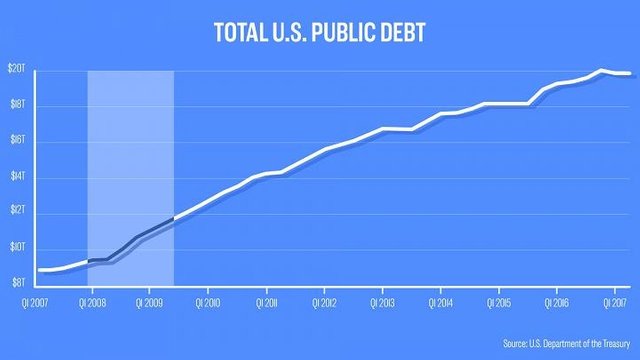
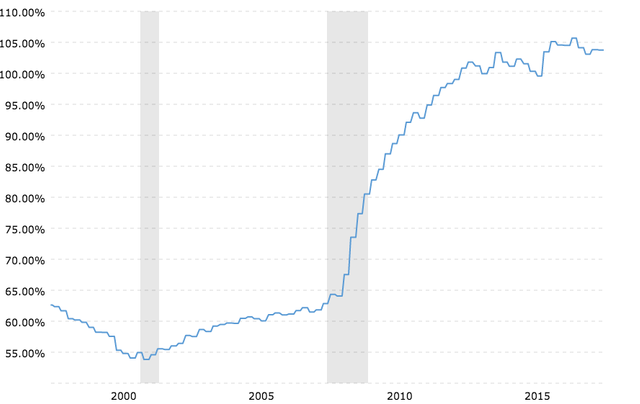
S&P 500
We can see lower lows and lower highs, meaning that we are on a downtrend.Stocks are overvalued, and the market is beginning to understand that
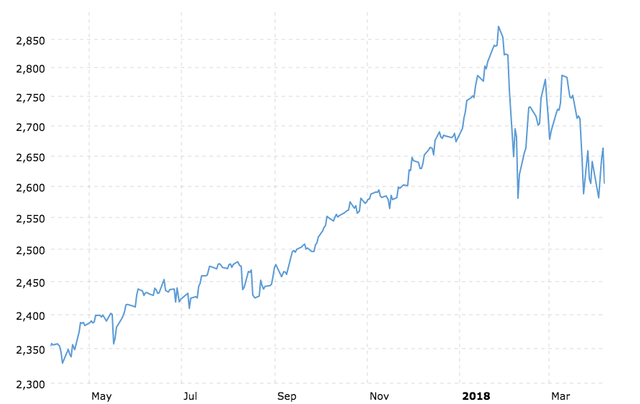
Dow Jones
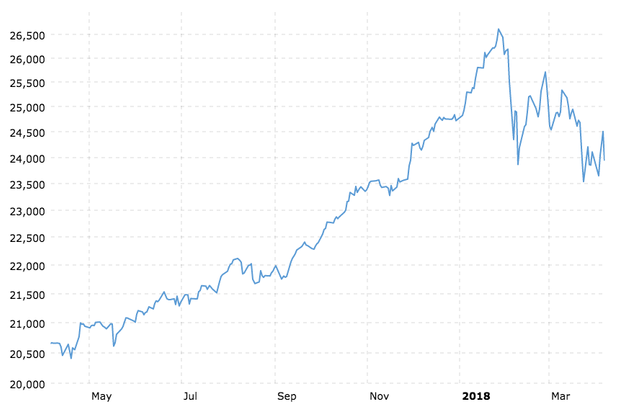
$VIX
The $VIX is a fear index, it helps in indicating the volatility of stock markets
We can see a growing trend which indicates the beginning of fear..
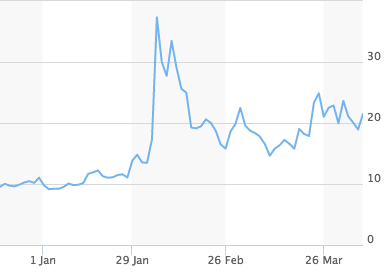
China's economy is shrinking
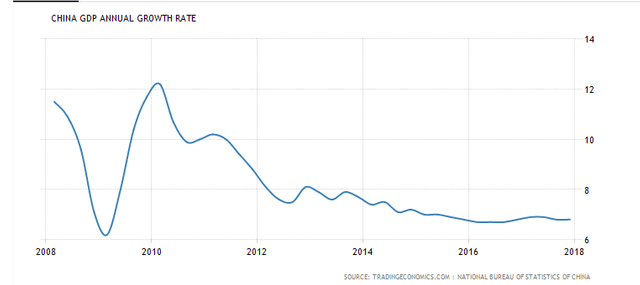
One of them is that China,the main engine of the world economy, is slowing down.The flow of farmers that move from the countryside to the cities and create the middle class, is draining, affecting global economy
Conclusion
The situation doesn't look so good, and we should expect volatility and an upcoming economic crisis,way stronger than we have ever experienced.
We are in an uncharted territory, because the consequences of huge amount of quantitative easing has never been tested into the economy yet.Nations are now in debt more than ever, and with all this low-interest money injected into the economy it's difficult to understand the real value of assets. We are in the bubble of everything, and this time we will not be able to recover with the old strategies.
With this huge amount of money into the system that doesn't correspond to a real value, fixed-supply assets will probably be seen as the safest choice to store value.
Be aware of inflation,
Stay Safe
This article is not an investment advice.
Sources:
Capital Economics
US Department of Treasury
www.tradingeconomics.com
www.imf.org
www.federalreserve.org
www.macrotrends.net
Congratulations @lucafra23! You have received a personal award!
Click on the badge to view your Board of Honor.
Do not miss the last post from @steemitboard: